Veritonic: Political AM/FM Radio Ad Best Practices: Use The Voice Of The Candidate And Customize The Ad To The Station Audience
Click here to watch a 10-minute video of the key findings.
According to AdImpact, for 2022’s midterm elections, political ad dollars are projected to reach $9.67 billion with “this election cycle outpacing 2020 by nearly $700 million dollars.” AdImpact expects AM/FM radio to take $270 million of the total political ad spend alone.
How can political campaigns optimize their use of their AM/FM radio advertising?
Brand new Veritonic analysis of political ads reveals two key best practices for political audio
The Cumulus Media | Westwood One Audio Active Group® partnered with Veritonic, the industry’s comprehensive audio analytics and research platform, to evaluate creative of two non-traditional approaches to political AM/FM radio ads – ads that were completely voiced by the candidate and ads that were customized to an AM/FM radio station’s audience that also sought voter input. Ads were tested among adults 18+ who were also asked about their political party affiliation.
Best practice: Use the voice of the candidate in the political AM/FM radio ad
Local and national personalities are one of the superpowers of AM/FM radio and podcasts. Utilizing trusted personalities in creative provides immediate credibility, endorsement, and relevance to listeners. If this works so well for talent reads, why not for political candidates?
Host-read ads also generate greater consumer attentiveness
In a March 2022 consumer study of 1,000 Americans 18+, Nielsen found 56% of podcast listeners and 44% of AM/FM radio listeners agreed that ads delivered by a host or personality got more of their attention than a pre-produced recorded commercial.
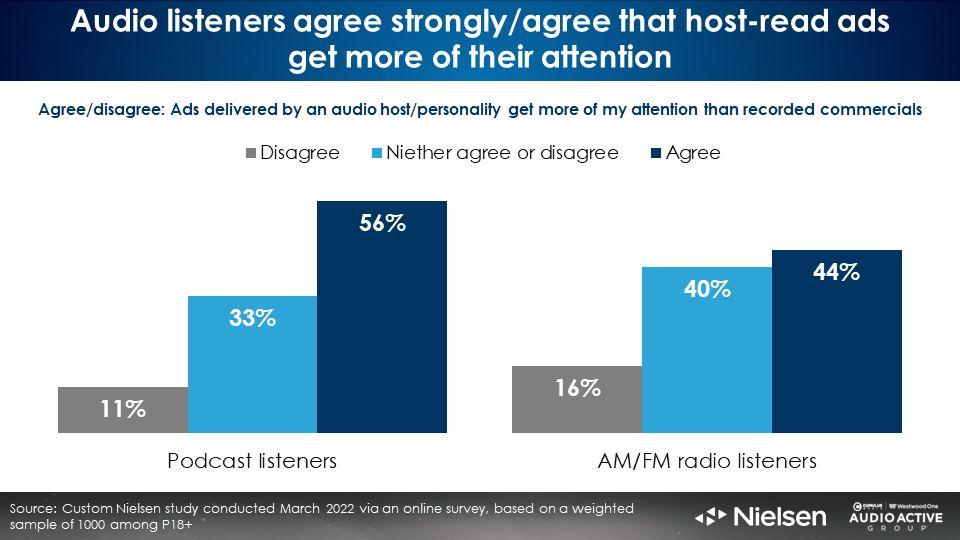
Political campaigns can follow this method by utilizing the voices of the actual political candidate. The Veritonic analysis reveals similar results.
Greater intention to vote: Ads voiced by a political candidate outperformed Veritonic political campaign benchmarks and political ads with a professional voiceover
In a typical political ad, the only time you hear a candidate’s voice is at the very end with the terse “I approve of this message” tag. In the Veritonic creative test, ads that were voiced by the candidate scored higher than ads that did not include the candidate’s voice.
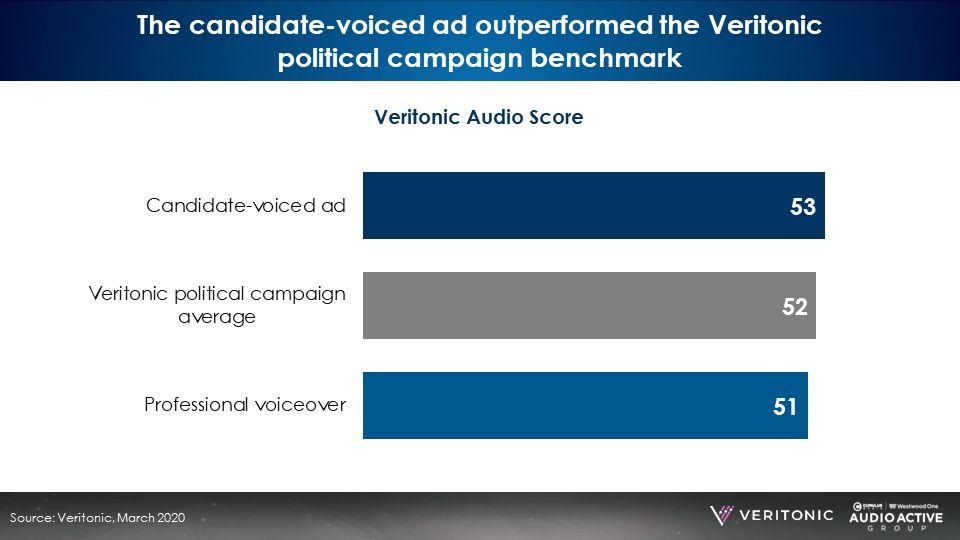
Using the candidate’s voice also increased voter intention. Comparing pre- and post-intent to vote for the candidate, ads voiced by the candidate versus a professional voiceover performed better.
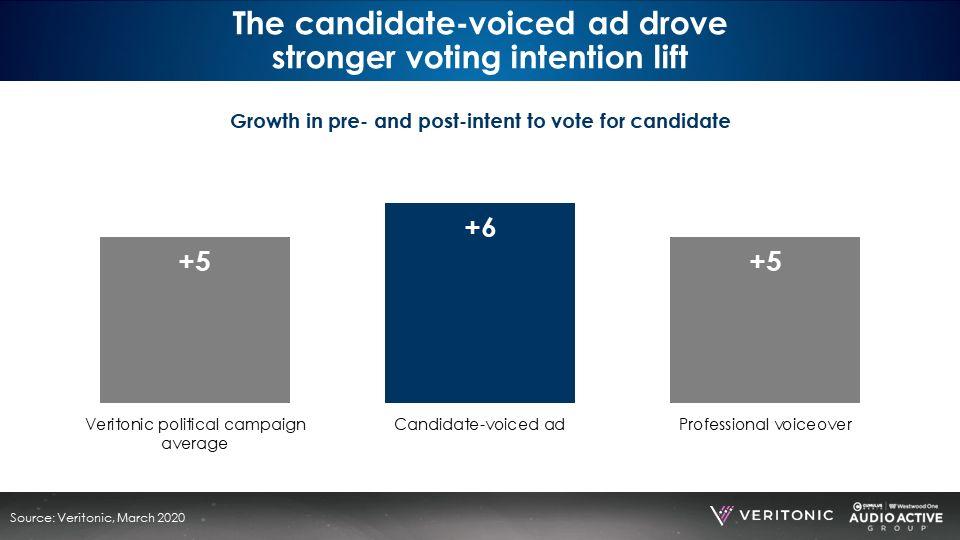
Candidate-voiced ads generate more emotional impact, the key to building positive candidate memories
Using a candidate’s voice in a political ad can also impact how a voter’s decisions are made by appealing to emotions. According to John Kearon, Orlando Wood, and Tom Ewing, “Positive emotion is the driving force behind profitable advertising.” In their book Sysyem1, Unlocking Profitable Growth, they describe how decision making is simplified by appealing to emotions that make people feel happy.
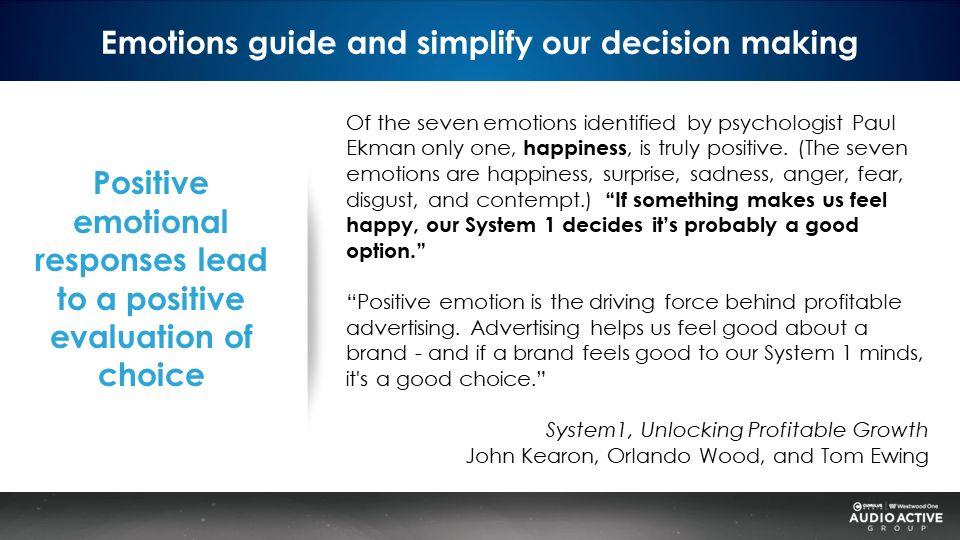
Candidates can use their voice in ads to generate positive emotions from their ads.
Veritonic found that candidate-voiced ads generated more positive emotions than professional voiceover ads. Respondents felt the ads made them feel excited, happy, and energetic.
Conversely, respondents also felt lower levels of negative emotions like sadness or nervousness with a candidate-voiced ad.
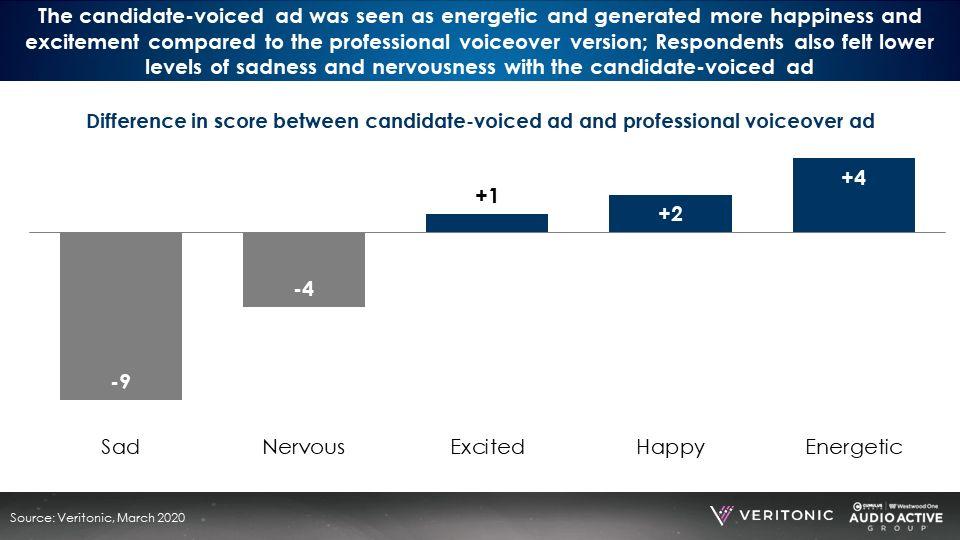
Two political ad approaches: Standard/classic political ads and innovative station-specific ads that seek input
There are two approaches to political campaign ads. Standard political ads are serious in tone, cite the political position of the candidate or party, make campaign promises, and are kept generic so that they can be used across many stations.
A new creative concept is a station-specific political ad that calls for input from the audience. These ads are youthful in tone, ask the listener to do something (either supply feedback or seek more information), and fit the energy of the station. They also include the station’s call letters or station name. The station-specific ad is distinctive and stands out from the typical political ad.
Veritonic tested each political ad for voter resonance.
Best practice: Customize political copy with station-specific verbiage that seeks input to stand out from typical political ads
Veritonic found that the station-specific ads achieved higher scores than generic ads.
Swing voters were the most receptive to the station-specific ads. According to Nielsen Scarborough, AM/FM radio delivers a massive 82% reach of Swing voters. Candidates can impact that huge audience and sway potential voters using creative that is tailored to the station.
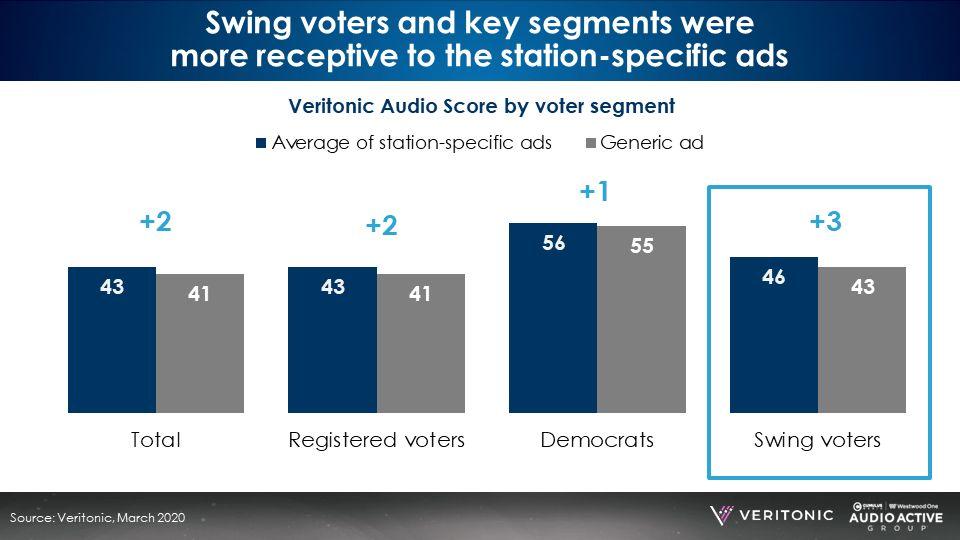
Station-specific ads seeking input generated greater positive sentiment
Similar to the candidate-voiced ads, station-specific ads saw higher rates of positive sentiment across important emotional markers: energetic (+14 point difference between the station-specific ad versus the generic), relaxed (+11), unique (+11), happy (+10), likeable (+9), powerful (+6), and empowering (+6).
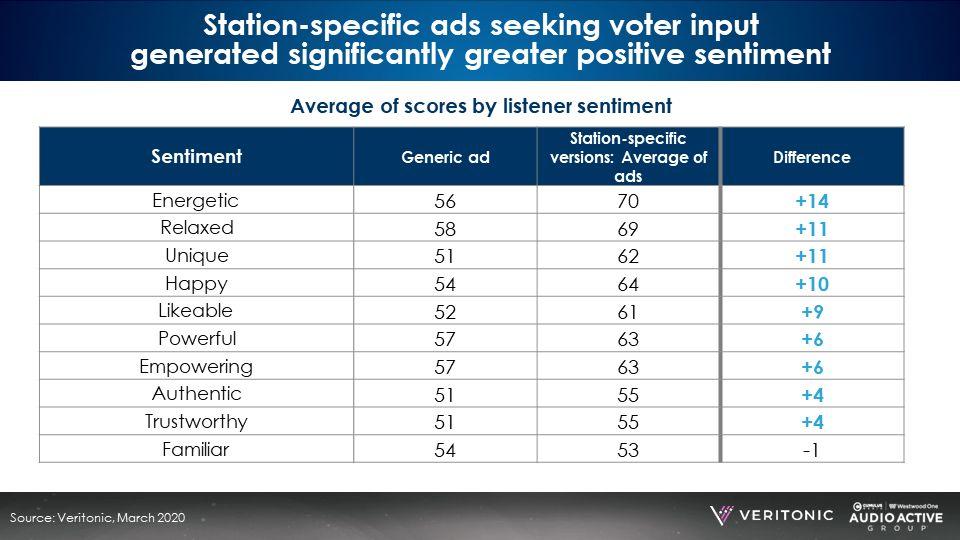
Station-specific ads deliver greater voter intent
Listeners were more likely to intend to vote for the candidate when exposed to the station-specific ads versus the generic political creative approach.
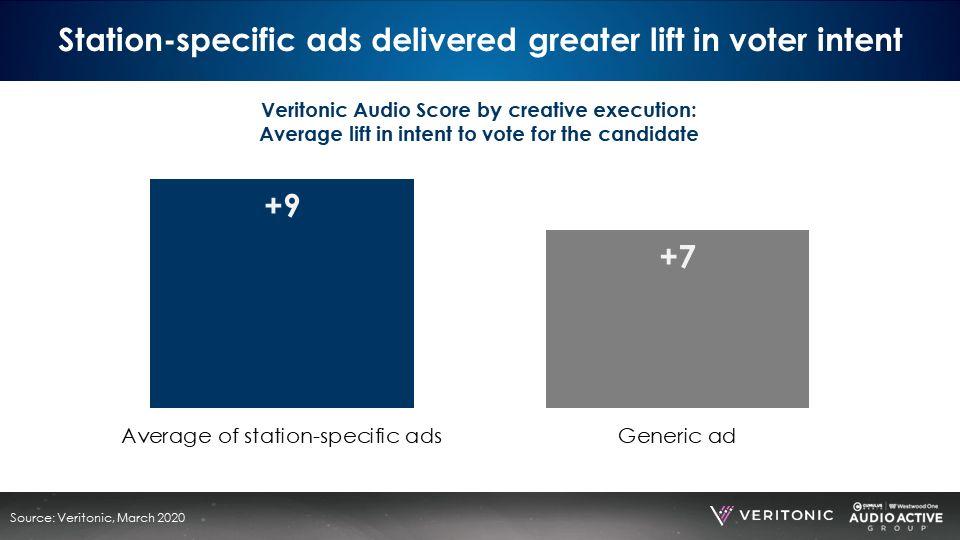
For political campaigns, AM/FM radio is the best audio platform to reach voters
Paying attention to political audio creative is important because AM/FM radio is a major presence in the lives of registered voters and across the entire political spectrum. According to Edison Research’s Q2 2022 “Share of Ear,” AM/FM radio has substantial ad-supported daily shares among registered voters (76%), Democrats (73%), Independents (75%), and Republicans (78%).
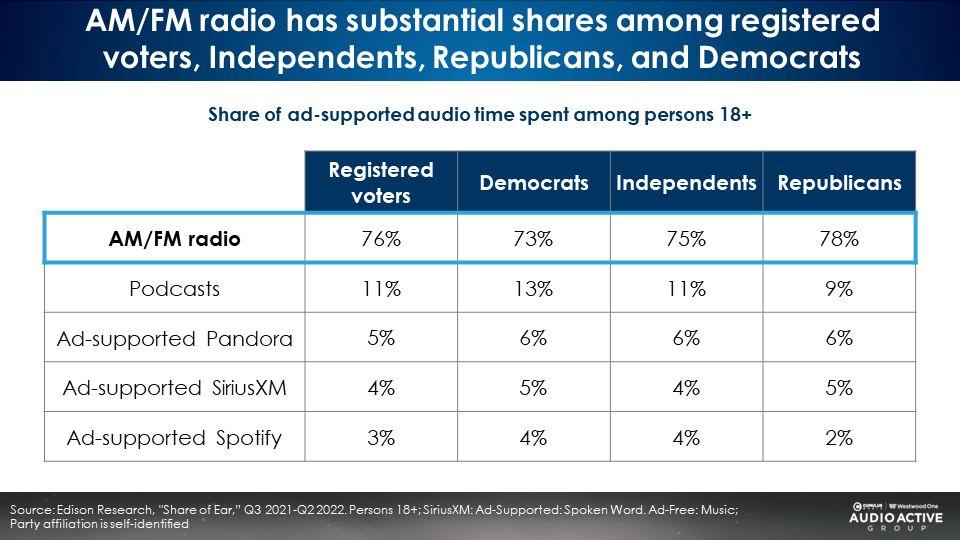
Nielsen: Since political races are decided by such slim margins, adding AM/FM radio to the plan optimizes media campaigns for the largest possible reach
Recently, Tony Hereau, Nielsen’s VP of Cross Platform Insights, made a presentation to the American Association of Political Consultants entitled The 10% Solution: Optimizing the Political Media Plan with Radio to Reach Swing Voters. His analysis finds that the addition of AM/FM radio to a political media plan can generate an extraordinary amount of incremental voter reach.
Using their media optimization platform, Nielsen Media Local Impact, Nielsen compared two media plans. The first consisted of a standard $250,000 political media plan with the following allocations:
- 50% broadcast TV
- 20% cable TV
- 15% OTT/CTV
- 15% digital
The second plan, optimized for greater voter reach with the same budget, had the following allocations:
- 45% broadcast TV
- 15% cable TV
- 15% OTT/CTV
- 15% digital
- 10% AM/FM radio
Introducing a 10% allocation for AM/FM radio caused reach to grow by 235,000 voters, an +8% increase. Impressions were up +7% while frequency was stable and CPM was more efficient.
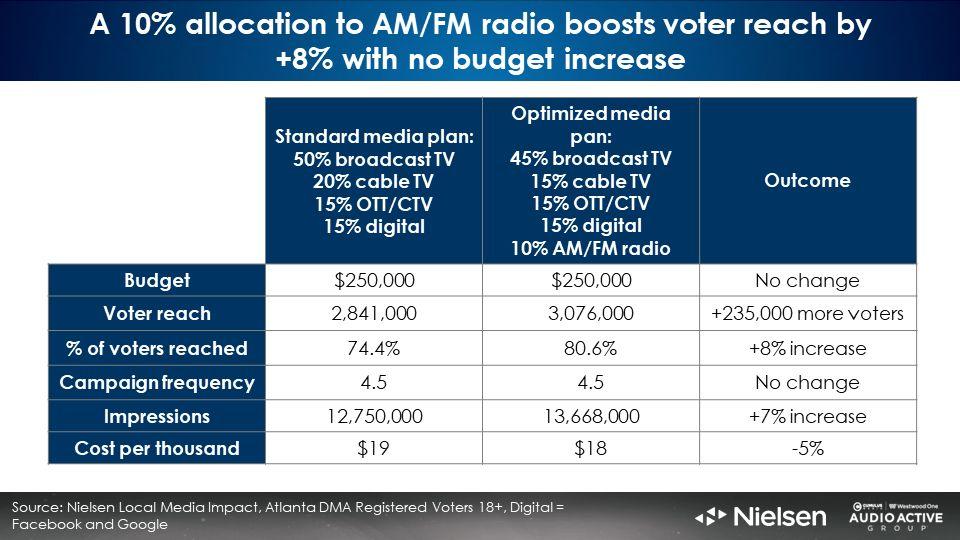
AM/FM radio works for political candidates
The media landscape is noisy and cluttered leading up to elections. Often, over a third of local TV ads are political.
AM/FM radio can help political candidates make an impact with innovative creative approaches. By using the candidate’s voice in an ad and tailoring copy to a station, campaigns can generate positive emotional response and increase voter intentions. Candidates can also use AM/FM radio to increase the reach of their campaigns at no extra cost to the media plan and reach the all-important Swing voters.
Key takeaways:
- Best practice: Use the voice of the candidate in the political AM/FM radio ad
- Host-read ads also generate greater consumer attentiveness
- Ads voiced by a political candidate outperformed both Veritonic political campaign benchmarks and political ads with a professional voiceover
- Candidate-voiced ads generate more emotional impact, the key to building positive candidate memories
- Best practice: Customize political copy with station-specific verbiage that seeks input to stand out from classic political ads
- Station-specific ads seeking input generated greater positive sentiment
- Station-specific ads delivered greater lift in voter intent
- For political campaigns, AM/FM radio is the best audio platform to reach voters
- Given that political races are being decided by such slim margins, adding AM/FM radio to the plan can help candidates optimize their media campaign for the largest possible reach
Click here to watch a 10-minute video of the key findings.
Pierre Bouvard is Chief Insights Officer of the Cumulus Media | Westwood One Audio Active Group®.
Contact the Insights team at CorpMarketing@westwoodone.com.